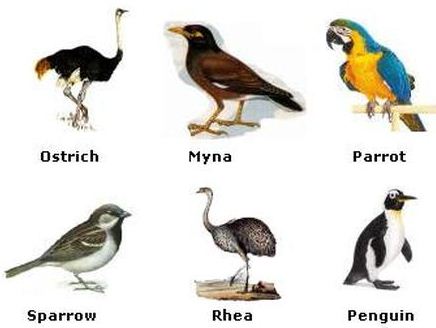Birds are one of the most intersting and widely known group of animals. There are more than 8600 species of birds distributed all over the world. Birds as a group exhibit a characteristic uniformity in structure.

Aves are warm blooded vertebrates with an exoskeleton of feathers forming a non-conducting covering to keep the body warm. The feet are cov-ered with scales. The forelimbs are modified as wings and provided with feathers for flight. The hindlimbs are attached far forwards to balance the weight of the body. The bones are spongy, containing air-cavities rendering the body light. There is a fusion of bones and this is especially seen in the vertebral column. Only three digits are present in the forelimbs. In the hindlimbs there are four toes with the first directed backwards. A horny beak is present.
The alimentary canal ends in a cloaca. Inside the body air sacs are present and some of them communicate with air cavities in the bones. The heart is four chambered. The red blood corpuscles are oval and nucleated. The kidneys are three lobed. The ureters open into the cloaca. Urine is semi-solid and contains uric acid. The nervous system is well developed. Eyes are usually powerful and a specialized structure called pecten is present inside the eye ball to help in accomodation. Sexes are separate, Fertilization is inter-nal. Eggs are provided with large amount of yolk. The egg is covered by a hard calcareous shell. In spite of several advanced features the birds have certain reptilian characters. Hence they are known as “glorified reptiles”.
Examples : Pigeon, parrot, crow, sparrow, peakcock, ostrich, penguin.











